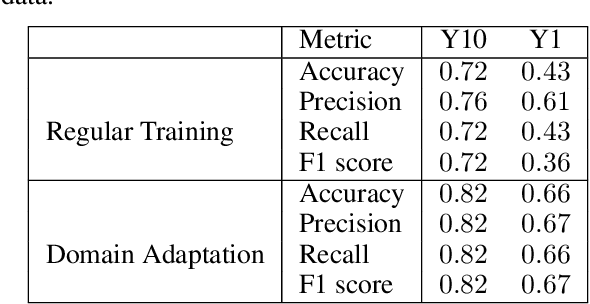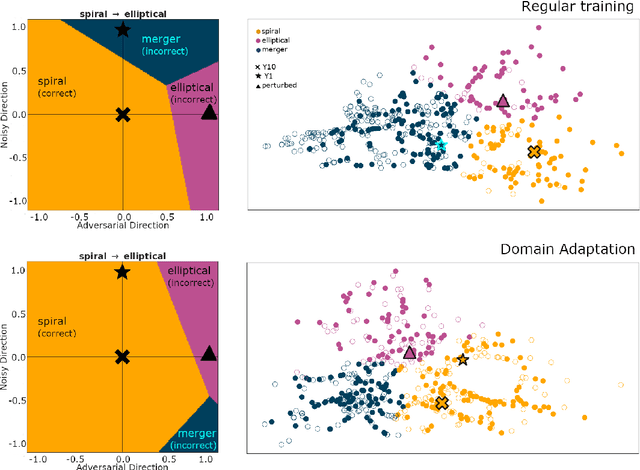K. Pedro
DeepAstroUDA: Semi-Supervised Universal Domain Adaptation for Cross-Survey Galaxy Morphology Classification and Anomaly Detection
Feb 03, 2023Abstract:Artificial intelligence methods show great promise in increasing the quality and speed of work with large astronomical datasets, but the high complexity of these methods leads to the extraction of dataset-specific, non-robust features. Therefore, such methods do not generalize well across multiple datasets. We present a universal domain adaptation method, \textit{DeepAstroUDA}, as an approach to overcome this challenge. This algorithm performs semi-supervised domain adaptation and can be applied to datasets with different data distributions and class overlaps. Non-overlapping classes can be present in any of the two datasets (the labeled source domain, or the unlabeled target domain), and the method can even be used in the presence of unknown classes. We apply our method to three examples of galaxy morphology classification tasks of different complexities ($3$-class and $10$-class problems), with anomaly detection: 1) datasets created after different numbers of observing years from a single survey (LSST mock data of $1$ and $10$ years of observations); 2) data from different surveys (SDSS and DECaLS); and 3) data from observing fields with different depths within one survey (wide field and Stripe 82 deep field of SDSS). For the first time, we demonstrate the successful use of domain adaptation between very discrepant observational datasets. \textit{DeepAstroUDA} is capable of bridging the gap between two astronomical surveys, increasing classification accuracy in both domains (up to $40\%$ on the unlabeled data), and making model performance consistent across datasets. Furthermore, our method also performs well as an anomaly detection algorithm and successfully clusters unknown class samples even in the unlabeled target dataset.
Robustness of deep learning algorithms in astronomy -- galaxy morphology studies
Nov 02, 2021



Abstract:Deep learning models are being increasingly adopted in wide array of scientific domains, especially to handle high-dimensionality and volume of the scientific data. However, these models tend to be brittle due to their complexity and overparametrization, especially to the inadvertent adversarial perturbations that can appear due to common image processing such as compression or blurring that are often seen with real scientific data. It is crucial to understand this brittleness and develop models robust to these adversarial perturbations. To this end, we study the effect of observational noise from the exposure time, as well as the worst case scenario of a one-pixel attack as a proxy for compression or telescope errors on performance of ResNet18 trained to distinguish between galaxies of different morphologies in LSST mock data. We also explore how domain adaptation techniques can help improve model robustness in case of this type of naturally occurring attacks and help scientists build more trustworthy and stable models.
Response to NITRD, NCO, NSF Request for Information on "Update to the 2016 National Artificial Intelligence Research and Development Strategic Plan"
Nov 05, 2019Abstract:We present a response to the 2018 Request for Information (RFI) from the NITRD, NCO, NSF regarding the "Update to the 2016 National Artificial Intelligence Research and Development Strategic Plan." Through this document, we provide a response to the question of whether and how the National Artificial Intelligence Research and Development Strategic Plan (NAIRDSP) should be updated from the perspective of Fermilab, America's premier national laboratory for High Energy Physics (HEP). We believe the NAIRDSP should be extended in light of the rapid pace of development and innovation in the field of Artificial Intelligence (AI) since 2016, and present our recommendations below. AI has profoundly impacted many areas of human life, promising to dramatically reshape society --- e.g., economy, education, science --- in the coming years. We are still early in this process. It is critical to invest now in this technology to ensure it is safe and deployed ethically. Science and society both have a strong need for accuracy, efficiency, transparency, and accountability in algorithms, making investments in scientific AI particularly valuable. Thus far the US has been a leader in AI technologies, and we believe as a national Laboratory it is crucial to help maintain and extend this leadership. Moreover, investments in AI will be important for maintaining US leadership in the physical sciences.
 Add to Chrome
Add to Chrome Add to Firefox
Add to Firefox Add to Edge
Add to Edge